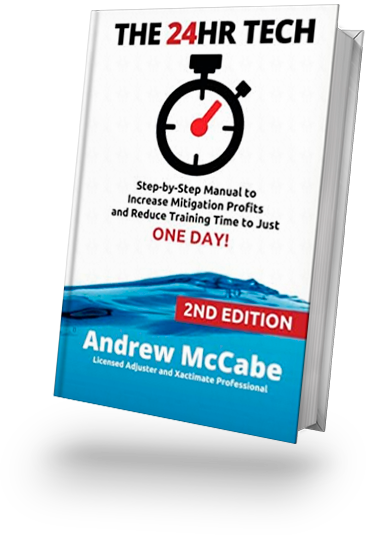Breaking Through: Marketing in a Crowded Marketplace
I recently had the pleasure of interviewing Richard Braun of 1800-RESTORE on my podcast: The Claim Clinic. He was kind enough to put together this article for us all to share. I hope you like it!
If you’d like to download the eBook/PDF version, here you go:
At the turn of the 20th century, marketing was much simpler and less crowded. Merchants set up shop, hung out their sign and sold their wares. Limited choices, proximity to population, and word of mouth drove consumer choices. Then came technology.
Before the 1920s, merchants primarily used print to advertise. In the 1920s radio advertising began and merchants obtained a new way to spread the word. In the 1940s television advertising was launched and became popularized in the 1950s. Also systemized in the 1950s was telemarketing. The 1980s gave birth to e-commerce and email marketing. Social media marketing became viral in the 1990s.
Today, decision makers are bombarded with hundreds of marketing and advertising messages per day. Some sources claim that Americans are exposed to over 5,000 ads per day. The point, of course, is that it is more and more difficult to stand out in a very crowded marketplace.
Independent businesses which are not attached to a national brand have even greater difficulty breaking through the marketing noise as the national players have the scope and dollars to create more brand awareness than local independent companies.
Solving this marketing riddle is the number one challenge of any business. Doing so can launch a business from mediocrity to greatness.
Below are five principles of marketing success:
Principle One: Refine your message – Start with a unique selling proposition
Before you begin telling your story, you must have a story to tell. Let’s face it. Most businesses, including yours, have A LOT of competition. You are not the one who provides the product and service that you offer. However, being able to identify and communicate what makes your offering unique is a key to success. As marketing guru Fred Berns states, “Tell them only what you do and they’ll buy only from you!”. Figure out your business’ “only” is the first marketing Principle. Check out Whatsyouronly.com for ideas on how to create your “only”. Then, craft your message around it.
Principle Two: Get the word out – Narrowcast not broadcast
If broadcast media was for the twentieth century, narrowcasting is for the twenty-first century. Audiences of the last century were able to be addressed in large-scale generalities. This is no longer accepted and you will lose your potential customer if you are not speaking specifically and directly to them. As a restoration company, each communication you craft should be directed specifically to your audience. If you are trying to reach claims adjusters, what is it about your business that helps them? If you are trying to reach homeowners who have a burst water heater, why should they call you? If your communication is intended for insurance agents, why do they care what you have to say? Each communication should be custom-tailored to its intended recipient.
Decision makers today want to know that you understand them. This is communicated when you talk specifically in terms of their needs and interests and how you address them. A message of last century might be “We mitigate and repair water, fire, smoke and mold damage.” A message like this would be addressed to all of your audiences. Today is different. Now you need to address homeowners and their interests, “We will fix your water damage and keep you in your home” or adjusters “We are able to mitigate and repair damage more quickly and minimize loss of use expense”. Narrow your message and speak it loudly.
Principle Three: Be found when buyers are looking
Once your message is clear and specific to your audience, make it easy for them to find you. People seek your services every day. Centers of influence are referring business to your competition every day. When a customer is looking, and a center of influence is referring, you need to be front and center.
On the web, make sure a professional webmaster has optimized your website and always keep your content fresh, new, and relevant. Have landing pages and content designed and customized for each type of person who you are trying to reach. Link to your content on social media sites. Write content for other websites and link back to your own website. Recycle content that you create and utilize the content in social media, your website, newsletters, and any printed collateral. Using the same content ensures brand-building consistency and provides a higher return on investment for everything that you do. Use pay per click advertising, when it makes sense, so that the people looking for you, find you, and then consume the message specifically tailored for them by communicating “your ONLY” in terms that matter to them.
With Google pay per click, you get 130 characters to stand out from your competition – 25 in a headline and 35 per row in three rows. With this few words, select your message carefully and target your message specifically to the searchwords. If a person searches “burst water heater” then you want your ad to be specific to the search:
Burst water heaters
We clean up the water and fix
Your water heater fast
You would not want a general wording to pop up:
ABC Restoration
Water, Fire, Smoke, Mold
Damage
Have your ONLY, narrowcast, and be easy to find.
Principle Four: Measure and Refine – Attack marketing scientifically
Once you have identified your only, crafted your messages specifically for your intended recipients and then made yourself easy to find, scientifically measure your results and refine your efforts.
In short, track everything. When a person calls your business, always capture key pieces of information, especially how they heard about you.
Your goal is to calculate your cost per lead and your cost per job as both a dollar amount and a percentage of revenue. By doing so, you can identify what marketing activities to do more of, and what to eliminate.
Keep in mind that this can be more challenging in practice than concept because much of what we do in marketing overlaps. For example, it’s important to recognize that while an insurance agency called because their CSR is looking at the calendar that’s stuck to their monitor, the CSR may have made the referral because of a combination of messages and efforts. Also as an example, you may receive a referral from pay per click; however, the “clicker” may have clicked on your ad not just because of the PPC message but also because they recognize your business from other efforts on your part and therefore, chose your company as a credible source.
Nonetheless, measure and analyze as best you can. Back in the 1990s, I ran a business that used a specific phone number in every yellow pages ad. We were able to track the cost per ad and watch it rise from $8 per call to an unprofitable $55 per call before we shut down tour yellow page advertising. Had we not been measuring our results, we would have wasted thousands of dollars in advertising before we figured it out. I watched as my competitors “hung in there” for several years afterwards while we shifted our marketing dollars elsewhere.
Principle Five: Become Unforgettable
You have a unique message. You are narrowcasting your message to your intended audience. You are being found when buyers are searching. You are scientifically approaching your marketing results.
Now comes the big win. The big win comes when you are the only one your buyer thinks of and they know how to reach you without searching for you. Up until this point, you always run the risk of being hidden in the sea of competitors when customers come looking for you, even if it’s you SPECIFICALLY they’re looking for to begin with. It’s time to become unforgettable and cut through all of the marketing noise.
If your buyers and referral sources reach you primarily through your website, your domain name needs to be ridiculously easy to remember and coincide exactly with your marketing message. A good friend of mine who owned a pest control business had great success by directing his customers to his unforgettable website: 123bugfree.com. It’s simple, it rhymes, and it was incorporated into all of his marketing… including his vehicles and TV ads. It’s magical because it’s unforgettable. Despite the hundreds of messages I am exposed to each day, I cannot forget the website. Kudos to him.
If your buyers and referral sources reach you primarily by phone, your phone number should be ridiculously easy to remember and coincide with your marketing message. Google “pet pharmacy online” you’ll get over 17,000,000 results. Whoa. But how many online pet pharmacies reach $233 MILLION in sales per year? How about 1? 1-800-PETMEDS is the self-proclaimed “America’s Largest Pet Pharmacy”. They didn’t get to be the largest pet pharmacy by selling better drugs. They got that size with more effective marketing and having an unforgettable brand that cuts through all of the marketing noise.
Marketing does not need to be complicated. In fact, simpler is better. Apply these five Principles and you will solve the biggest problem that every business faces – successful marketing in a crowded marketplace. Happy Selling!
 Richard Braun is the Marketing Director for 1-800-RESTORE, a growing national network of independent restoration companies. Richard is known for applying his marketing experience to grow several successful companies in the Hampton Roads, Virginia Area. Richard has a BSBA in Marketing from Old Dominion University. To obtain a free marketing ROI worksheet to measure and analyze your own marketing results, go to the 1-800-RESTORE contact page and enter “ROI” in the message field along with your information.
Richard Braun is the Marketing Director for 1-800-RESTORE, a growing national network of independent restoration companies. Richard is known for applying his marketing experience to grow several successful companies in the Hampton Roads, Virginia Area. Richard has a BSBA in Marketing from Old Dominion University. To obtain a free marketing ROI worksheet to measure and analyze your own marketing results, go to the 1-800-RESTORE contact page and enter “ROI” in the message field along with your information.
http://www.1-800-restore.com/contact-us.html
Also published on Medium.



